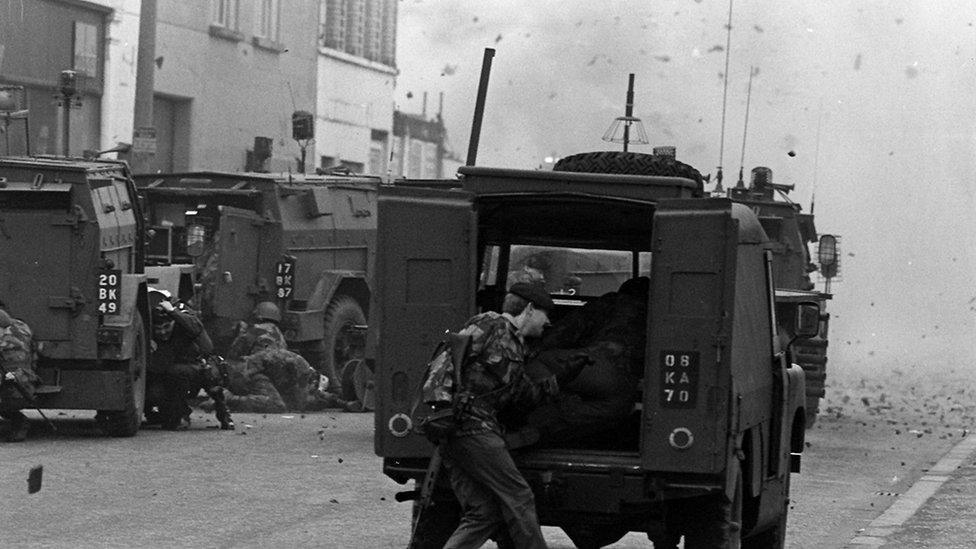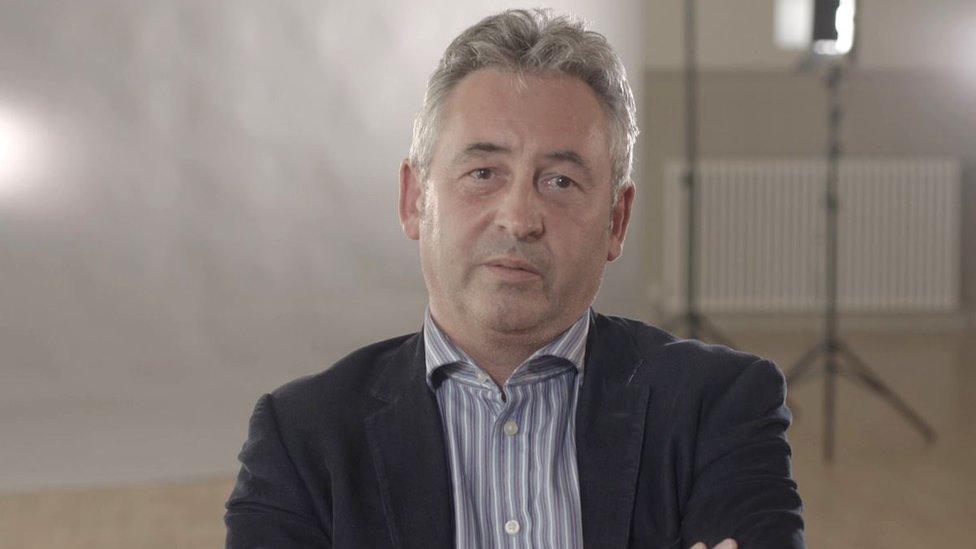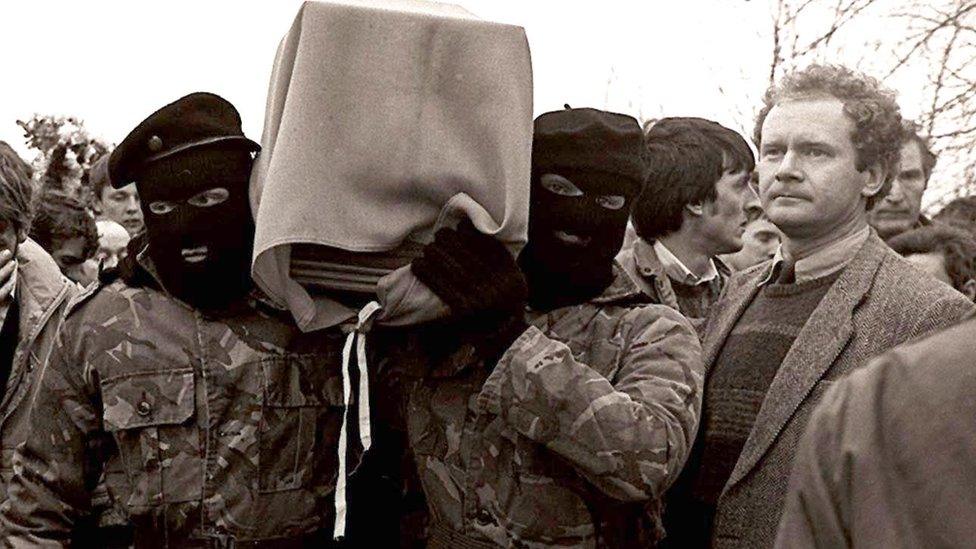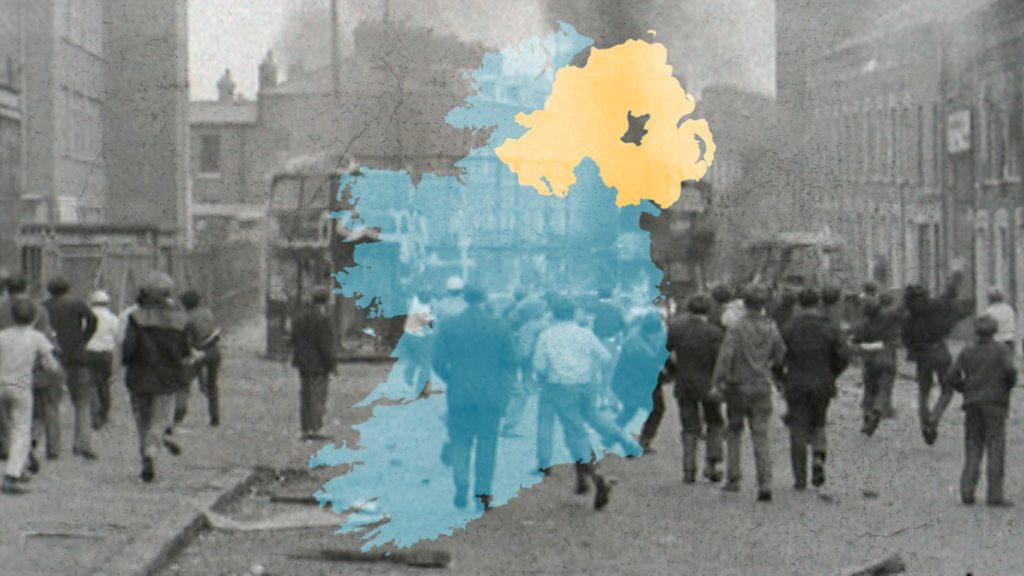Shooting The Darkness: Capturing the violence of the Troubles
- Published

A woman confronts a soldier at Whiterock in Belfast during the Troubles
"I really got my eyes opened - I was really, really scared."
When the violence of the Troubles erupted in Northern Ireland, it was press photographers like Paul Faith who were there to capture it.
He and many others were effectively thrust into the role of war photographers - except the bloodshed was not half a world away, but on the streets of their own towns.
These people witnessed some of the worst atrocities of the conflict.
Now, seven of them have shared their experiences in a film to be broadcast on Monday night.
Shooting the Darkness - which features personal testimony, archive footage and still images - reflects on how many went from working on sport or farming news to portraying images of almost unimaginable pain and suffering.
Initially, Paul Faith was an onlooker to the horror of the Troubles, a 30-year period of conflict which saw 3,500 people killed and many more injured.
"The daily work would be town hall receptions, dinners, unfurling of Orange banners, parades in the town, cheque presentations - and I was just bursting to get out to do news," he told the documentary.
"I would go home at night, turn on the news and there were bombs going off in Belfast, people being killed. It was just mayhem elsewhere. I just needed to get out, I felt as if it was just my calling."

Soldiers running from a bomb in the Smithfield area of Belfast
On one of his first assignments, he recalls shaking "from one end of the road for three miles to the other end" as he covered a republican parade protesting against internment, a government policy to imprison people without trial.
"You could see the vengeance and the hatred. The soldiers were scared, the republicans were vicious to them and it was just a completely different world," he said.
He talks about republicans being very "media savvy" at that time.

Photographer Paul Faith was thrust into a different role when violence erupted in Northern Ireland
An abiding memory was the 1998 funeral of IRA man Brendan Burns, when he captured the moment Sinn Féin's Martin McGuinness stood beside the coffin, alongside masked men.
"It was bandit country. The Army and police were there in force with riot shields. We weren't sure what was going to happen, but we knew if something did happen it was going to be bad," he said.

Paul Faith captured this scene at the funeral of IRA man Brendan Burns
"As the service was ending, the coffin was going to come out, the Chinooks [helicopters] were landing, six IRA guys appeared in full camouflage gear, fully masked, berets the whole lot.
"At the coffin, McGuinness was at the front on the right-hand side, no words were spoken."
He added: "The Provos had played their ace; they got what they wanted in this picture of Martin McGuinness beside the IRA guys, carrying the coffin."
The spiral of violence
March 1988 saw escalating violence culminating in some of the most infamous imagery to emerge from the Troubles.
A fortnight of brutal violence began with the shooting dead of three IRA members in Gibraltar by the Army.
Later that month, their funeral at Milltown Cemetery was attacked by loyalist Michael Stone. Three people were killed, dozens were wounded.

Martin Nangle said it is better to treat what he does as a job, and not get too involved
Three days later, as one of Stone's victims was being buried, the mourners were said to be fearful of another attack.
On the scene was photographer Martin Nangle - who captured some of the most memorable images of that day, images that would be beamed around the world.
He was there working when two plain-clothed British soldiers drove into the path of the funeral.
Corporals Derek Wood and David Howes were dragged out of a car and beaten. They were later stripped and shot dead by the IRA, their bodies dumped on waste ground.

Martin Nangle took a series of photographs of the scene in Andersonstown more than 30 years ago before the soldiers were killed
Martin was on hand to capture what happened - but feared the footage would be confiscated as cameramen had been threatened and told to stop filming.
"It became pretty evident that if I wanted to get this story out what was in the camera had to be taken out and new film put into the camera, wound on, reeled up - so that if I was asked for the film I would open the camera and rip it out and it would look like it was being destroyed," he said.
"It worked insofar as the story got out and the images got out."
Martin said he always looked out for a picture that would help describe the narrative of the Troubles.
"When I saw Belfast for the first time, I was quite shocked at the degree of decaying grandeur, so to speak, that was happening all over the city. This proud Victorian city [was] basically rotting around us," he said.
But he knew he had to document the effect violence had on the people and the social fabric of Northern Ireland.
A personal cost?
"It's probably better to view the world when you are in a situation like that from behind a camera," he said.
"Your mental process is going through composition, when to make that decision to press the shutter.
"Staying behind the camera is a safety valve to separate yourself from sinking into the event and becoming part of it, which is what you don't want to do.
"It's better just to treat it as a job, as an observer and not to get too close."
It's a view echoed by Paul Faith.
"Your only saving grace was you had a camera. You had something physically in front of you. In a way, it was probably like watching a TV screen."
But he added: "You couldn't do this job without being touched."
Shooting The Darkness, by Broadstone Film, will be broadcast on BBC One Northern Ireland on Monday 23 November at 22:45 GMT.
Related topics
- Published13 August 2019
